High-rise Building : Structural System & Services Abhinav Chunchu [2010BARC001] Sandeep Verma [2010BARC057] Vishal Ekka [2010BARC058] Shrivan W [2010BARC079] 25 Sept 2014
Content
• Definition of High-rise
• Evolution
• Structural Systems
• Comparative analysis of structural systems
• Wind load and Effects
• Foundation Types
• Damping Systems
• Services
Fire fighting systems
Vertical circulation
Plumbing
• Wind tunnel testing
• Case-Study : Hines Tower, Shanghai
Definition of High-rise
A tall building is not defined by its height or number of stories. It is the building in which “tallness” strongly influences planning, Designing and use. It is a building whose height creates different conditions in design, construction and operation from those that exist in “common” buildings of a certain region and period.
A high-rise structure is considered to be one extends higher than the maximum reach of available fire fighting equipment in absolute numbers, This has been set variously between 75-100 ft.
Ref. : Building Structure Illustrated by Francis DK Ching, Barry S. Onouye, Douglas Zberbuhler
High-rise security and fire life safety by Geoff Craighead
Definition of High-rise
India
Hyderabad : High-rise building is one with 18m or more in height
Bhopal : High-rise building is one with 18m or more in building height
Mumbai : High-rise building is one with 7 floors or more, or one with 24m or more in building height
Bangalore : High-rise building is one with ground floor plus four or more floors above the ground floors.
Chennai : High-rise building is one with ground floor plus four or more floors above the ground floors.
Kolkata : High-rise building is one with ground floor plus four or more floors above the ground floors.
Ref. : High-rise security and fire life safety by Geoff Craighead
Bhopal Building Bye laws
Brihan Mumbai Municipal Corporation (BMMC)
Bangalore mahnagarapalika Building Bye Laws (2003)
Greater Hyderabad Municipal Corporation (GHMC)
Chennai Metropolitan Development Authority (CMDA)
What is Tall Building?

a) Height Relative to Context
b) Proportion
c) Tall Building Technology


Ref. : CTBUH (Council on Tall Buildings & Urban Habitat)
Evolution
Spire or Dome Heights
Skyscraper evolved in two different urban environment
• Chicago (Banking, Finance)
• New York (Commercial activities clustered around broadways)
These factors served as the setting for cast-iron framed structures which augured the skyscrapers
Evolution
A.T. stewart’s second store, New York, 1859-62
illustrated the capacity of new iron construction
Around 1880 builder gave rise to elevator buildings


Equitable Life Assurance Society Building (Begun 1868, Enlarged 1875-76, 1886-89)
Ref. : The Tall Building Reference Book by Dave Parker & Antony Wood
(Data as of January 2013)
Building Structure Illustrated by Francis DK Ching, Barry S. Onouye, Douglas Zberbuhler

Evolution
A.T. stewart’s second store, New York, 1859-62
illustrated the capacity of new iron construction
Around 1880 builder gave rise to elevator buildings

Ref. : The Tall Building Reference Book by Dave Parker & Antony Wood
(Data as of January 2013)
Building Structure Illustrated by Francis DK Ching, Barry S. Onouye, Douglas Zberbuhler

History of the World’s Tallest Building
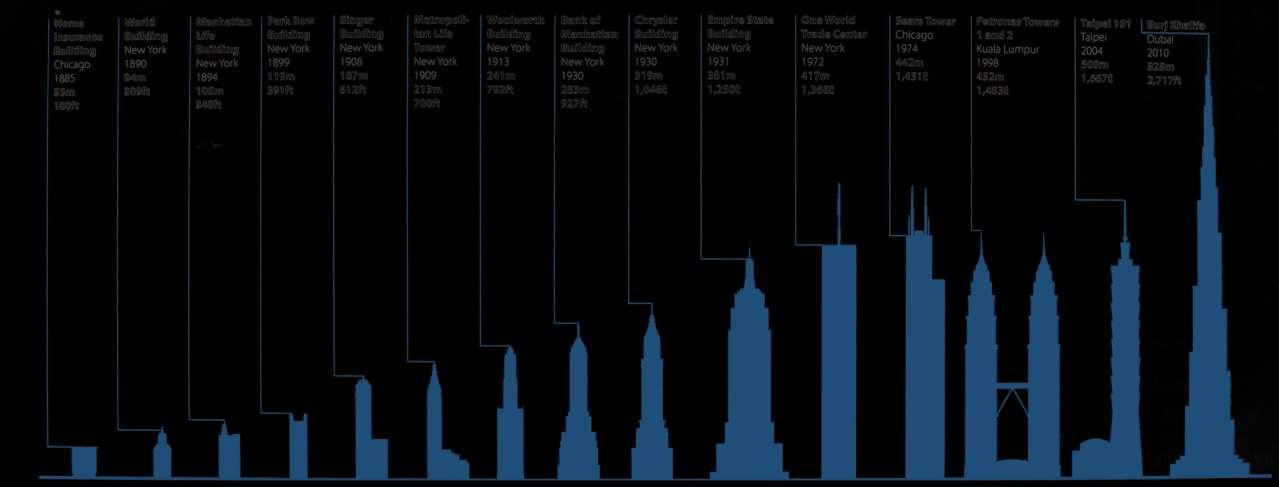
Ref. : The Tall Building Reference Book by Dave Parker & Antony Wood
(Data as of January 2013)
Average Height of the 100 tallest buildings
0 50 100 150 200 250 300 350 1930 1940 1950 1960 1970 1980 1990 2000 2010 2012 150 169 170 178 197 229 255 285 323 341 Height (in meters)
Ref. : The Tall Building Reference Book by Dave Parker & Antony Wood (Data as of January 2013)
External Loads
Wind Load
• Direct pressure
• Suction
• Drag
Seismic Load
• Inertial force
Effects of lateral loads
• P -Delta Effect
• Overturning Moment
• Vortex Shedding
Ref. : Building Structure Illustrated by Francis DK Ching, Barry S. Onouye, Douglas Zberbuhler
High-rise security and fire life safety by Geoff Craighead
Direct Pressure
Received by building surfaces perpendicular to wind’s path(windward direction)
Suction
Side and leeward building surfaces, as well as windward roof surfaces having a slope of less that 30 ° This results in negative pressure which may result in roofing or cladding failure
Drag Generated on the surfaces parallel to the windward direction
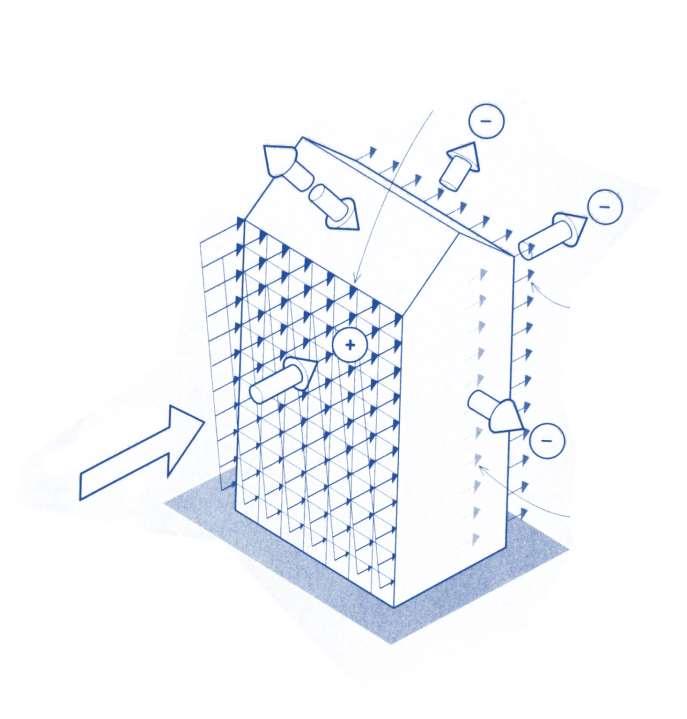
Direct Pressure
Drag Suction
In contrast to vertical gravity loads, the effect of lateral loads on buildings are not linear and intensify rapidly with increase in height
P DELTA EFFECT
When gravity load is displaced laterally by a distance (delta) due to wind, seismic, or balanced gravity loads, it generates forces and additional deflections throughout the structure added deflection generate further p delta effect.
OVERTURNING MOMENT
Any lateral load applied at a distance above grade generates an overturning moment at the base of a structure. For equilibrium , the overturning moment and an internal resisting moment provided by forces developed in columns members and shear walls

Lateral Loads
P = KV²
P= Pressure
K= coefficient of wind
V = velocity of wind
K= 0.006 for conventional
rectangular building
VORTEX SHEDDING


In fluid dynamics, vortex shedding is an oscillating flow that takes place when a fluid such as air or water flows past a cylindrical body at certain velocities, depending on the size and shape of the body. In this flow, vortices are created at the back of the body and detach periodically from either side of the body.
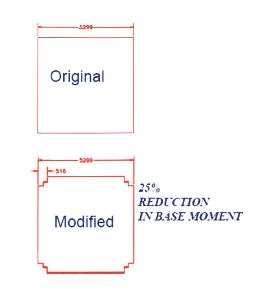
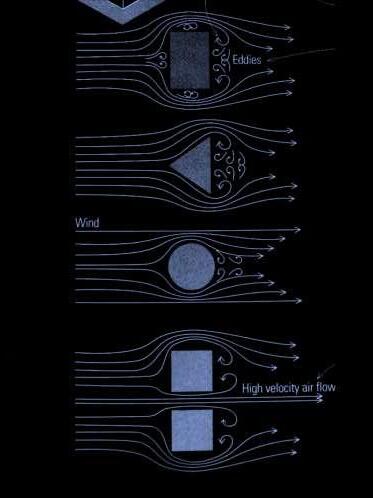
JOHN HANCOCK BUILDING, CHICAGO
• Determine the nature and intensity of wind forces acting on the structure
• Model of scale 1:100 or 1:200 or 1:400
• For model of 1:400, wind speed in tunnel and full scale wind of 1:3 is chosen.
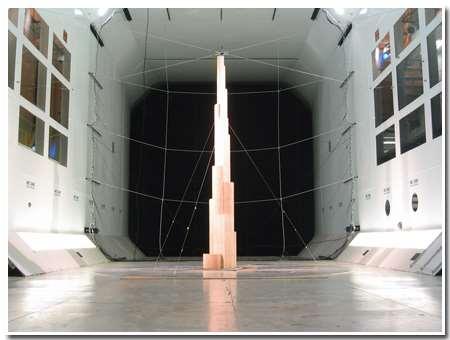
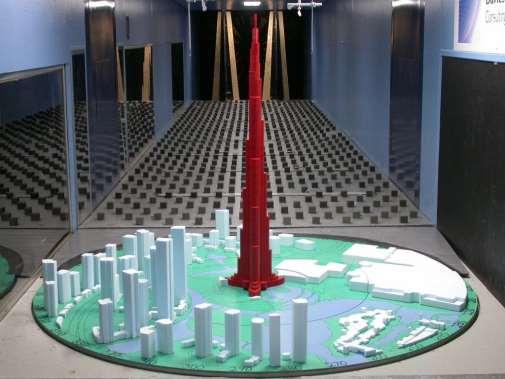
• This results in time scale of 1:133
• To limit damage to the cladding on the building façade and to partitions and interior finishes.
• To reduce effect of motion perceptibility.
• To limit the P- delta effect.
Wind Tunnel test
OUTRIGGER SYSTEM
• Generally in form of steel truss or reinforced concrete or composite.
• Tied to the core and combined with exterior columns
• Reduce overturning moment and lateral shift
• Under load shear core tend to bend and the out rigger act as lever arm

• Use at different levels: create mechanical floors
BELT TRUSS SYSTEM

• Placed on exterior wall panels
• Strong and stiff subsystem
• Reduce the shear lag
• Entire story depth can be used to construct mechanical floor
• It distributes loads equally on exterior columns
TYPES OF STRUCTURES

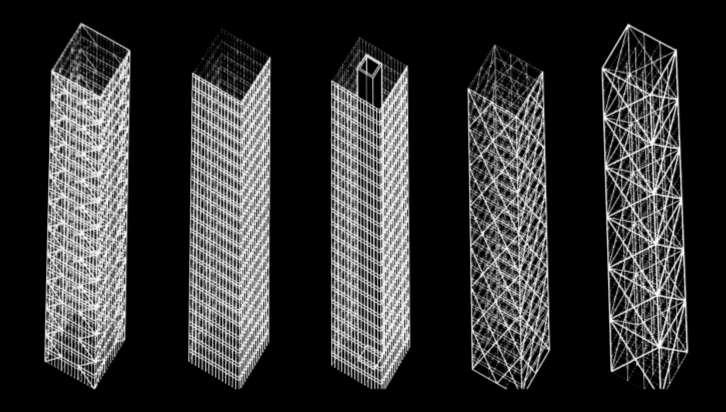 BRACED FRAME RIGID TUBE TUBE IN TUBE DIAGRID TRUSSED TUBES
BRACED FRAME RIGID TUBE TUBE IN TUBE DIAGRID TRUSSED TUBES
RIGID FRAME SRUCTURE


• Resist Shear+ bending moment
• Height efficiency
Steel = 30 floors
Concrete = 20 floors
• Column size increases towards the base of the building.
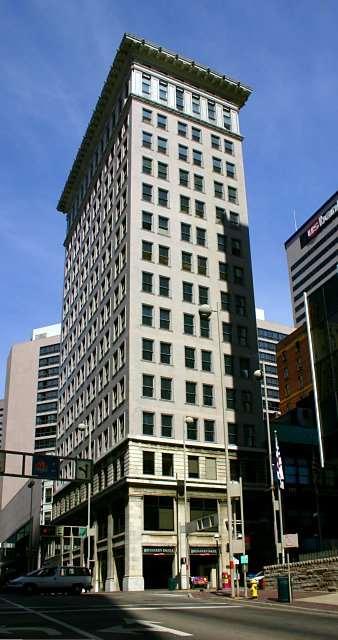

• become cost-prohibit for use in buildings exceeding 35 stories.
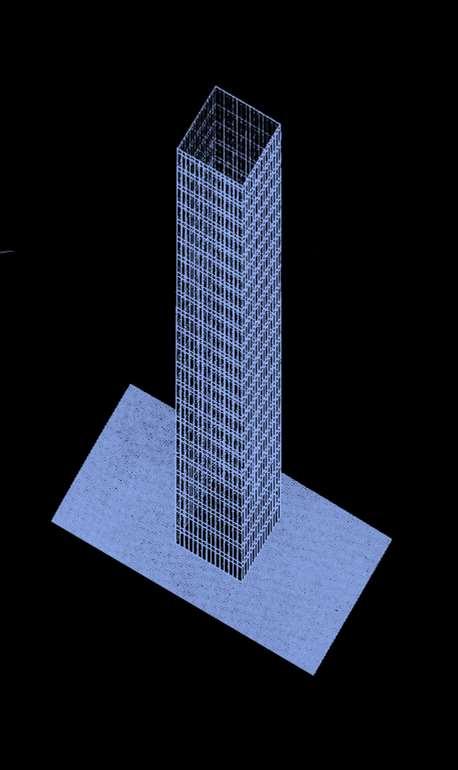
Lake shore drive apartment, Chicago Ingallas Building, Cincinnati Ohio
SHEAR WALL CORE RIGID FRAME STRUCTURE:
Shear walls and rigid moment resisting frames.
• Greater lateral rigidity for building

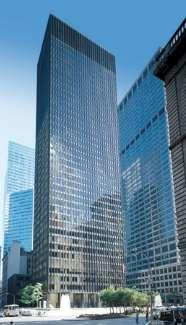
• Capacity to rise unto 60 floors.
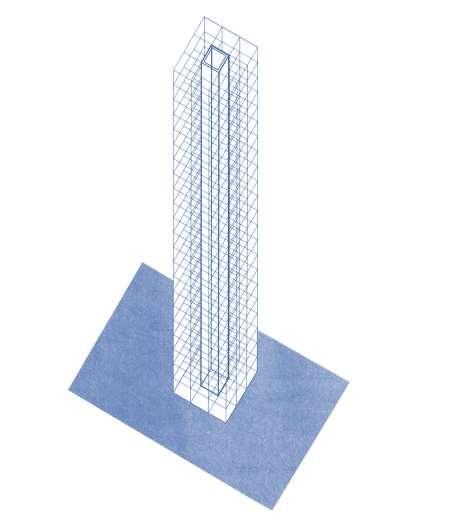
•
Seagram Building
Cook County Administration Building,Chicago
TYPES OF BRACINGS.
A typical column and beam frame is assumed To be joined with pin or hinged connections, Which can potentially resist applied vertical loads. Four hinged quadrilateral is inherently unstable, However, and would be unable to resist a laterally Applied load.


K bracing consist of two diagonal braces that meet near the Midpoint of vertical frame member. Each diagonal member Can be subject to either tension or compression, depending On lateral force acting on the frame.
V bracing consist of diagonal braces that meet near the midpoint Of horizontal frame member .
The additional of diagonal bracing system Would provide the requisite lateral stability To the frame.
Knee braces used in pairs to resist the lateral forces From either directions.
Chevron bracing is similar to V bracing but its orientation Allows for passage through the space below the inverted V.
Diagonal bracing consists a pair of diagonals. A certain degree of redundancy is achieved If each diagonal alone is capable of stabilizing the frame.
Single diagonal braces: able to handle both tension and compression.
Diagonal tension counter systems consist of cable or rods that Work primarily in tension. A pair of cables or rods is always necessary to Stabilize the frame against lateral forces from either directions. For each force direction, one cable of road will operate effectively in Tension while the other becomes slack and it assumed to carry no load.
ECCENTRICALLY BRACED FRAMES
• Eccentrically braced frames may also be designed to control frame deformations and minimize damage to architectural elements during cyclical seismic load.

• The link beam absorb energy from seismic activity through plastic deformations of other members.

• Steel is ideal material for braces frames because of its ductility- the capacity to deform without fractures combined with its high strength.
• Eccentrically braced frames are generally placed in the exterior wall planes of a structure but are also sometimes used to brace steel frame cores.
BRACED FRAME SRUCTURE
• Vertical truss: resist lateral loads
• K,V,X members eliminating bending under lateral loading.
• Column girder and diagonal bracing are connected by pin joints.

• Fabrication is more economical than other moment resisting connection in rigid framed structure
 • John Hancock building, chicago
• John Hancock building, chicago
BRACED FRAME SRUCTURE WITH SHEAR CORE

• Shear walls: To resist the lateral load caused by wind & earthquake
• Relatively thin: height/width

• The assembly of shear walls is known as “coupled shear wall”
• Belt trusses distribute the tensile and compressive force to the large no. of exterior trusses

Shanghai Financial Centre, Chaina Empire State Building (NewYork)
BRACED CORE STRUCTURE:
• Shear Resisting core
• Minimized possibility of torsion due to lateral load

• May contain one or more cores
Connected by outriggers to provide column free space

• Out rigger generally form of steel trusses or reinforced concrete
• connect core to the peripheral columns, reduce the overturning moment and lateral drift in the building.

TUBE STRUCTURE:
• Utilize entire building to resist lateral loads.

• Outer frame: closely spaced columns rigidly connected to deep spandrel beams.
• Loads are transferred by external frame
Exterior column spacing 5ft to 15 ft (1.5 m-4.5 m)

Spandrel beam depth 24 in-48 inch (600-1200mm)
Shear lag reduced by use of belt truss placed on exterior wall panels.
Belt truss used to equalize tension and compression forces due to shear lag.
 Shanghai world financial center
Shanghai world financial center
TUBE IN TUBE STRUCTURE:

Stiffness of framed tube is improved by using structural core.


• Resist gravity as well as lateral loads.
• Floor diaphragms tie the exterior and interior tube together

• Allowing two tubes to resist as one unit



•
Tabung haji tower, malesia
One shell plaza Texas
DDA building, new Delhi
BRACED TUBE STRUCTURE:

Framed tube + Diagonals = braced tube
• Diagonal braces and spandrel beams give wall like rigidity against lateral loads
• Stiffening the parameter frames overcomes the shear lag problem faced by framed tube.

•
John Hancock centre, Chicago
BUNDLED TUBE STRUCTURE:
• Cluster of individual tubes tied together to act as a single unit
• framed tubes are bundled at the base and terminates at different levels, without loss of structural integrity
• Single tube : height restriction –slenderness ratio
• Height efficiency : 110 story
• Advantage: flexibility of organizing floor areas
• Individual tube can be of any shape rectangular, triangular, hexagonal
110 story sears tower designed by SOM


• Framed steel tubes- each with structural integrity
• Individual tubes bundled together in varying configuration and terminated at various levels breaking the wind sway by breaking flow of the wind.
Sears Tower, Chicago
Skidmore, Owings & Merrill (Bruce Graham)

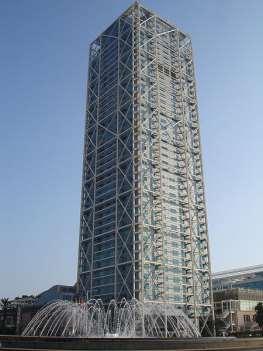
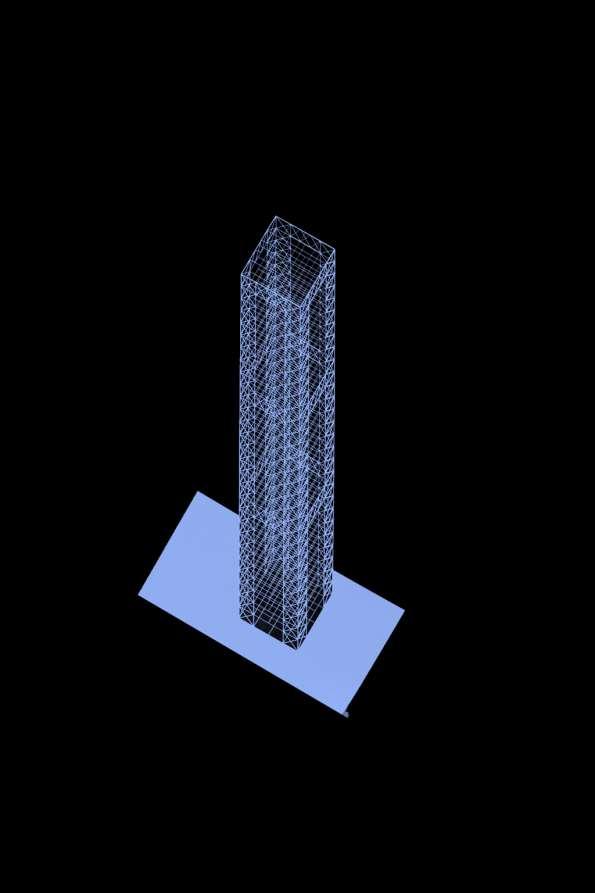
• • • • •
MEGAFRAME STRUCTURE:
Example : Tuntex sky Tower, Taiwan
Hotel de las Artes, madrid
SPACE TRUSS STRUCTURE:
IDEA of stacking triangulated prisms which contain diagonal bracing the exterior and interior frame.



• Resist both lateral + vertical loads
• Diagonals prominent part of interior parts.

– I.M.Pie

•
bank of china building
Diagonal Tower
South korea, by SOM
DIAGRID STRUCTURE


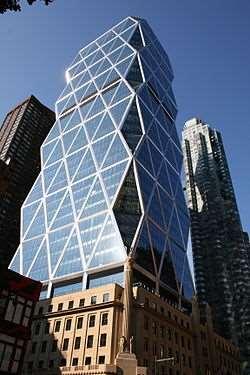
Proposed by Sir Norman Foster
Height efficiency:
Concrete: 60
Steel : 100
• Lattice work on exterior
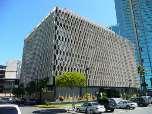
• Resist both lateral & gravity loads
• Vertical columns eliminated
• Triangulation ( gravity and lateral loads)



- uniformly distributed
• Shear deformation minimized
• Resist shear through axial action rather than by bending vertical columns & spandrel
• Both shear & bending rigidity to resist the effects of drift & overturning moment.
• Highly redundant – can transfer loads through multiple paths in case of a localized structural failure.
Hearst Tower (Above)
Swiss Re Headquarters (left below)
IBM Building (Right below)
Lake Shore Drive Apartments (Chicago, USA) Assurance Tower (Kansas City)
20 Provide flexibility in floor planning. Easily mouldable.
Braced Hinged Frames Steel Shear Trusses
+ Steel
Outrigger Structures
Shear Cores(Steel
Trusses or Concrete
Shear Walls) + Outriggers (Steel
Trusses or Concrete Walls) + (BeltTrusses) + Steel or Concrete
Composite (Super) Columns
35 Effectively resists lateral shear by concrete shear walls.
Interior planning limitations due to shear walls.
Interior planning limitations due to diagonals in the shear trusses. Expensive diagonal connections. Shear Wall / Hinged Frames
77 West Wacker Drive (Chicago, USA), CasseldenPlace (Melbourne, Australia)
150 Effectively resists bending by exterior columns connected to outriggers extended from the core.
Category SubCategory Material / Configuration Efficient Height Limit Advantages Disadvantages Building Examples Rigid Frames Steel
30 Provide in floor planning. Fast construction flexibility. Expensive moment connections. Expensive fire proofing. Concrete
Hinged Frames
Expensive formwork. Slow construction. Ingalls Building (Cincinnati, USA)
10 Efficiently resist lateral loads by axial forces in the shear truss members. Allows shallower beams compared with the rigid frames without diagonals.
Low-rise buildings Concrete Shear Wall + Steel Hinged Frame
Outrigger structure does not add shear resistance. Taipei 101 (Taipei, Taiwan), Jin Mao Building (Shanghai, China)
Category SubCategory Material / Configuration Efficient Height Limit Advantages Disadvantages Building Examples Shear Wall (or Shear Truss)Frame Interaction System Braced Rigid Frames Steel Shear Trusses + Steel Rigid Frames 40 Effectively resists lateral loads by producing shear truss - frame interacting system. Interior planning limitations due to shear trusses. Empire State Building (New York, USA), SeagramBuilding Shear Wall / Rigid Frames Concrete Shear Wall + Steel Rigid Frame 60 Effectively resists lateral loads by producing shear wall - frame interacting system. Interior planning limitations due to shear walls. Seagram Building, (New York, USA) Concrete Shear Wall + Concrete Frame 70 Tube Framed tube steel 80 Efficiently resist lateral loads by locating lateral system at the building perimeter. Shear lag hinders true tubular behaviour Narrow column spacing obstruct the view AON Centre ( Chicago, USA) concrete 60 “ “ Water tower place (Chicago, USA) Braced tube steel 100( + interior) / 150( - interior) Efficiently resist lateral shear by axial forces in the diagonal members. Wider column spacing possible compared with framed tubes. Reduced shear lag. Bracing obstruct the view. John Hancock Centre ( Chicago , USA) concrete 100 “ “ Onterie Centre ( Chicago) Bundled tube steel 110 Reduced shear lag. Interior planning limitations Sears Tower ( Chicago) Tube in tube Ext. Framed Tube (Steel or Concrete) + Int. Core Tube (Steel or Concrete) 80 Effectively resists lateral loads by producing interior shear core - exterior framed tube interacting system. Interior planning limitations due to shear core. 181 West Madison Street (Chicago, USA)
concrete 100
“ Expensive formwork. Slow construction. O-14 Building (Dubai)
Efficiently resists lateral shear by axial forces in the space truss members.
Could
Building
of China (Hong Kong, China)
Chicago World Trade Center (Chicago, USA)
Venezuela)
Category SubCategory Material / Configuration Efficient Height Limit Advantages Disadvantages Building Examples Diagridsteel 100
concrete 60
Space Truss Structures
steel 150
Efficiently resists lateral shear by axial forces in the diagonal members. Super frames
Complicated joints. Hearst Building (New York,USA), 30 St Mary Axe, also known as Swiss Re Building (London, UK)steel 160
Obstruct the view. May obstruct the view.
Bank
produce super tall buildings.
form depends to a great degree on the structural system.
“ “ Parque Central Tower (Caracas,
Thank you



















 BRACED FRAME RIGID TUBE TUBE IN TUBE DIAGRID TRUSSED TUBES
BRACED FRAME RIGID TUBE TUBE IN TUBE DIAGRID TRUSSED TUBES













 • John Hancock building, chicago
• John Hancock building, chicago








 Shanghai world financial center
Shanghai world financial center

























